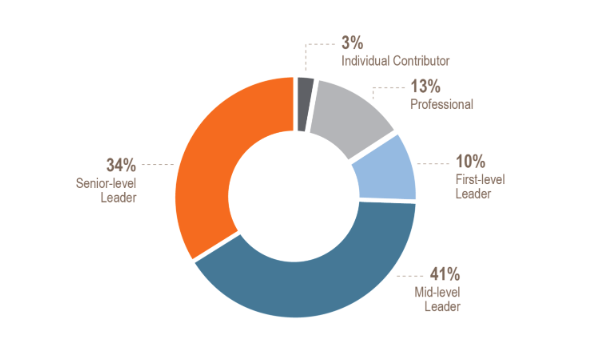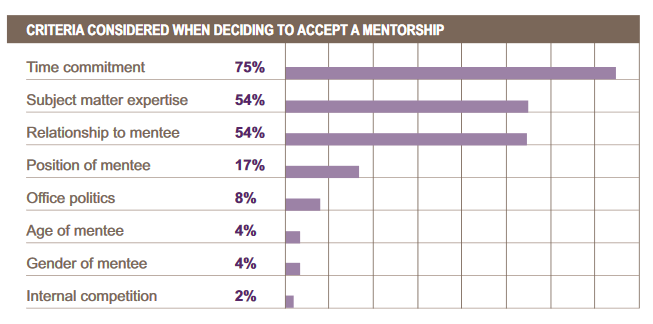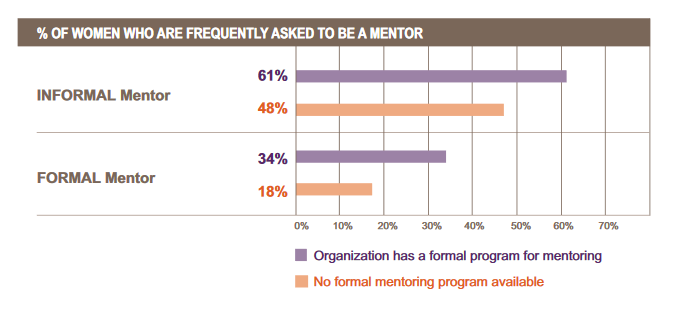Research via Images
Here is a succinct view of what research surveyed a total of 318 businesswomen from 19 different countries and 30 different industries. The respondents on average were 48-years old, with the large majority (75 percent) indicating that they were either mid- or senior-level leaders. This research throws light on whether women make great mentors
(see Figure 1).

It’s not a competition
The number one reason cited for why women mentor is because they want to be supportive of other women—80 percent agreed (see Figure 2). Additionally, the majority of women (74 percent) indicated that they mentor because they have benefited from their own mentorship experiences.
Figure 2: Women back one another

It’s About Time
The majority of women (75 percent) reported that the time it takes to mentor most affects their decision to accept mentorships. In fact, time commitment was the number one decision criterion for women in taking on a mentoring role (see Figure 3). As it turns out, perception does not match reality—once women commit to mentoring, they find that the time it takes to mentor is not a hindrance to their work.
Figure 3: What holds women back from mentoring

Mentoring: Formal = Normal
Along with mentoring not being a common practice for women, it was discovered that mentoring is unchartered territory for most organizations. Only 20 percent of women in the study rated the quality of formal training they received as high or very high, and another fifth of women (22 percent) responded that they have not received any training at all (see Figure 4). This data tells us that rather than having a planned talent strategy in place, organizations are leaving mentoring to chance.
Figure 4: Mentors Need Help

Formal mentoring programs provide an easier way for women to find mentors, and the numbers of women who report having a formal mentor clearly reflect that (see Figure 5). In organizations with formal programs, half of all women have had a formal mentor in comparison to only one in four at organizations that do not have such programs. Three out of four women who work for an organization with a formal program reported that they always accept mentoring opportunities.

Figure 5: Make Mentoring Formal
Formal programs encourage mentoring
Women in higher-level positions at organizations with formal programs reported not only being asked more frequently to be formal mentors, but informal mentors, as well (see Figure 6). Among organizations with a formal program for mentoring, one in three women (34 percent) reported being asked frequently to be a formal mentor, in contrast to less than one in five women (18 percent) at organizations without such a program.
Figure 6: Formal Programs Encourage Formal Mentoring

The data confirm that having formalized programs for mentoring helps increase mentoring. More organizations need to not only put programs in place, but also ensure they are providing mentors with effective training and development opportunities to equip them with the necessary skills. They need to remove the ambiguity of what it means to mentor by better defining the “what” and “how” of mentoring. Note to organizations: It is easy to remove the barriers holding women back from seeking out mentoring opportunities.
Mentoring: Make Sure It Happens
With today’s complex business climate, mentoring is more critical than ever. Women are ready to be mentors, and to be mentored, so what will it take to make sure it happens? This research demonstrates what organizations, mentors, and women need to do in order to ensure a high payoff from mentoring.
This is part of a very interesting research conducted by the folks at DDI World. If you do have some time would recommend reading their insightful article (link below) from which these research data points have been collated.Source for the survey results & graphs : https://www.ddiworld.com/resources/library/trend-research/women-as-mentors-does-she-or-doesnt-she



